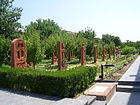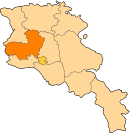Oshakan
Oshakan
Օշական | |
|---|---|
 Oshakan as seen from the western side of Didikond Hill. | |
| Coordinates:40°15′48″N44°18′53″E/ 40.26333°N 44.31472°E | |
| Country | Armenia |
| Province | Aragatsotn |
| Municipality | Ashtarak |
| Population (2010) | |
| • Total | 5,822 |
| Website | http://oshakan.am/ |
Oshakan(Armenian:Օշական) is a village in theAshtarak Municipalityof theAragatsotn ProvinceofArmenialocated 3 kilometers southwest fromAshtarak.It is well known to historians and pilgrims of theArmenian Apostolic Churchas the site of thegraveofMesrop Mashtots,the inventor of theArmenian alphabet.
History
[edit]During theArsacid dynastyof theKingdom of Armenia,it served as the main town ofAyraratprovince and the capital of its Aragatsotn canton from which theAmatuninoble family ruled. However, Oshakan is best known for theSaint Mesrop Mashtots Churchwhich is the burial place ofSaint Mesrop Mashtots,the creator of theArmenian alphabet.The church houses his grave and was rebuilt by CatholicosGeorge IVin 1875. Wall paintings on the interior were done in 1960 by the artist H. Minasian. Saint Mesrop Cathedral is the seat of the Aragatsotn Diocese of theArmenian Apostolic Church.
Just to the south of the town is the Didikond Hill, where excavations have uncovered a fort and five palaces built around the 7th to 5th centuries BC.
To the north of town located in the Mankanots Valley isSaint Sion Churchdating from the 7th century AD. It is believed to mark the grave ofByzantine EmperorMauriciusor his mother, as one historian claims he came from Oshakan. Adjacent to the church is a pillar on a plinth dated to the 6th or 7th century.
West of Oshakan is a bridge dated to 1706 that crosses over the Kasagh River.
On a hilltop overlooking the town there is aTukh Manuk Shrinewith a largekhachkarmonument adjacent that sits within a large cemetery. The portion of the cemetery higher upon the hill is the older section while the lower portion contains a recent cemetery. There are Iron Age tomb fields around the area. Higher upon the same hill may be seen the shrine of Saint Grigor. Nearby are also the shrines of S. Sargis, S. Tadevos the Apostle, and a rock-cut Astvatsatsin.
The village of Oshakan is mentioned in a 13th-century inscription on the southern wall of the Katoghike Church of theAstvatsnkal Monasterybuilt between the 5th and 13th centuries. It reads,
"By the grace and mercy of God, I Kurd, Prince of Princes, son of the great Vache, and my wife Khorishah, daughter of Marzpan, built the Holy Katoghike for the memory of our souls. We have decorated it with every kind of precious ornament and offered the garden bought by us inParpi,virgin land inOshakan,a garden inKarbi,a villager (?), and three hostels, in theyear 693/AD 1244. "[1]
Oshakan is known to have had a brief visit during October 1734 byAbraham Kretatsiduring the time while he was serving the CatholicosAbraham II.He wrote a short passage speaking of his previous days stay atMughnito visit theMonastery of Surb Gevorg,"In the morning, after services, we went down to Oshakan."
Sister cities
[edit]Gallery
[edit]-
Saint Mesrop Mashtots Cathedral built in 1875-79
-
The front facade of Saint Mesrop Cathedral
-
Armenian Alphabet khachkars at the Saint Mesrop Cathedral yard
-
Tukh Manukshrine with the large khachkar adjacent, while the Surp Grigor Chapel is also seen in the background
-
Cemetery below Didi Kond Hill with the shrine of Surb Grigor in the background
-
The shrine of Surp Grigor on Didi Kond Hill overlooking the village
-
TheArmenian alphabetmemorial in Oshakan
See also
[edit]References
[edit]- ^Franklin, Kathryn J.; Vorderstrasse, Tasha; Babayan, Frina (April 2017)."Examining the Late Medieval Village from the Case at Ambroyi, Armenia".Journal of Near Eastern Studies.76(1): 128.doi:10.1086/690559.
- OshakanatGEOnet Names Server
- World Gazetteer: Armenia[dead link]– World-Gazetteer.com
- Report of the results of the 2001 Armenian census
- Oshakan
Bibliography
[edit]- Hacikyan, Agop J. (2005),The Heritage of Armenian Literature, Vol. 3: From the Eighteenth Century to Modern Times,Detroit, Michigan:Wayne State University Press,ISBN0-8143-3221-8
- Kiesling, Brady (2005),Rediscovering Armenia: Guide,Yerevan, Armenia:Matit Graphic Design Studio
- Kiesling,Rediscovering Armenia,pp. 14, available online at theUS embassy to Armenia's website
External links
[edit]40°15′48″N44°18′53″E/ 40.26333°N 44.31472°E











